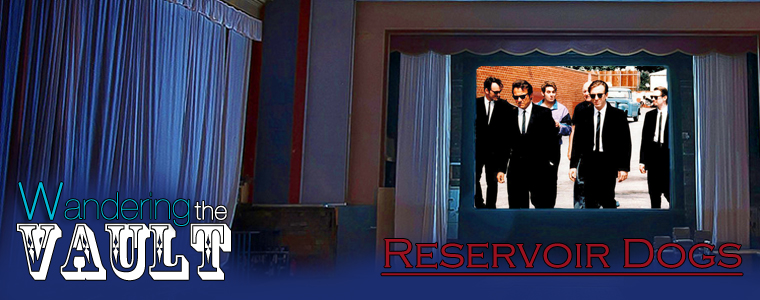Reservoir Dogs and the Tarantino Experience
by Andrew Collins
Until last Tuesday, I had never seen a Quentin Tarantino film. I knew his movies were typically quite violent — easy enough to infer from the trailers of Inglourious Basterds and the soon-to-be-released Django Unchained — but that was about it. I stereotyped him as someone obsessed with spectacle and being edgy for its own sake because that sort of thing sells these days.
Now that I’ve had a little more exposure, courtesy of Miramax and Fathom Events, this impression proved not so much wrong as incomplete. Yes, every Tarantino film comes tagged with an R-rating (or they’re unrated), but he also strives to be a master of the craft — concerned just as much with story and character as with spectacle.
It was only fitting that I start from the beginning. This year marks the 20th anniversary of Tarantino filmmaking. In celebration, Miramax released a blu-ray box set of the top eight Tarantino films and launched a one-night theatrical showing of his first film, the cult-sensation Reservoir Dogs, and Pulp Fiction later that week.
Enough people showed up at the Reservoir Dogs screening so that none of the rows in the theater were empty. Instead of trailers for upcoming movies beforehand, we were treated to original theatrical trailers from the Tarantino films in the box set. Miramax then showed a brief documentary about how Reservoir Dogs came to be, followed by several trailers for old, obscure films from Tarantino’s private collection.
Tarantino was still in his twenties when Reservoir Dogs appeared in the Sundance Film Festival early in 1992. His inexperience shows, but almost in a good way. If you want to see what raw filmmaking talent looks like, watch Reservoir Dogs. It’s not often that one finds such a clear picture of the bridge from low-budget amateur to Hollywood big shot.
Those interviewed in the documentary that showed before the screening described the young Tarantino as an extraordinarily gifted artist who lived and breathed movies — someone who never had to blossom into a filmmaker because he was born already blossomed. He worked as a grip before making Reservoir Dogs — worked and wrote. His script caught the attention of actor Harvey Keitel, who went on to play one of the lead roles in the film. Suddenly armed with several solid actors and an increased budget, Tarantino was like an amateur artist ready to create his first masterpiece with a #2 pencil who suddenly found himself with an easel, canvas, and paints. Indeed, Reservoir Dogs bursts with the vision of a man who knows exactly what he wants to do and is determined to do it. He seemed to roll easily to victory at Sundance and there launched a wildly successful career.
Among a slew of quotes from Tarantino on the website for this event, one stood out to me, seeming to illuminate Reservoir Dogs particularly well:
“When it comes to the actual writing of the piece, it’s about character. I don’t lead the characters, I let the characters lead me.”
For this reason, and perhaps this reason alone, Reservoir Dogs succeeds. Despite an absence of backstory for all but one of the characters and a non-linear narrative, the film grabs me because the “Reservoir Dogs” — a group of men recruited to pull off a jewel heist and named after colors — are so darn interesting.
All it takes is the first scene, where we find the Misters White, Orange, Blonde, Pink, Blue, and Brown, respectively, seated in a breakfast diner. They have been gathered by crime maven Joe Cabot (Lawrence Tierney) to execute the perfect heist, but we don’t get to watch that scene until almost the end of the film. For now, they’re just talking about stuff. Mr. Brown (played by Tarantino himself) offers a very explicit interpretation of Madonna’s song “Like a Virgin,” Mr. Pink (Steve Buscemi) explains why he refuses to tip at restaurants, and Mr. Blonde (Michael Madsen) offers to shoot Mr. White (Keitel) on behalf of Cabot. They’re a classy bunch in their suits and skinny ties, but hardly a class act.
Next thing you know, a bloodied Mr. Orange (Tim Roth) is writhing in the backseat of a car and whining about how he is going to die from his gunshot wound. Mr. White, in a moment of deadpan humor (where it’s hard to tell whether he or Tarantino is the one trying to be funny), tries to comfort him by explaining that he is not a trained medical professional, therefore he has no idea what he is talking about, therefore he is not going to die (at least not right at the moment). They stumble into an empty warehouse, meet Mr. Pink, and we learn that the heist has gone horribly wrong. One of them must be a police informant.
From there, Reservoir Dogs rides wave after wave of character-driven vignettes that gradually explain why all these guys were together in the first place and why everything went wrong. Unlike most crime and action flicks these days, it’s a fairly simple story that would be quite boring if it had been told chronologically. There are no surprising plot twists and only one freak accident to guide the events. We just like to watch Misters White, Orange, Blonde, Pink, Blue, and Brown being themselves and interacting with each other.
I suspect that Tarantino designed Reservoir Dogs to progress so that the audience gradually grows desensitized to the dense profanity (there are about 270 “f-words”) and all the blood and violence. That was my experience at least, and by the time the film ended with the tragic death of the only heroic character, I hardly felt anything. The screen faded to black, and credits appeared to the funky tune of Harry Nilsson’s song “Coconut.” Everyone in the theater applauded. And after a moment of dumb contemplation, I realized I had kind of enjoyed the whole thing.








